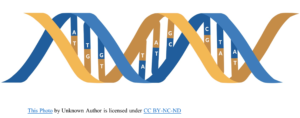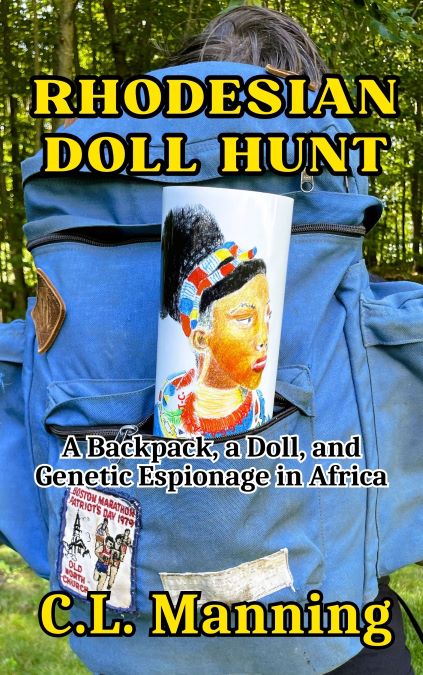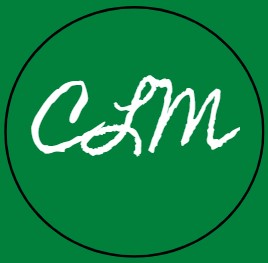

CHAPTER 10 ATCG
We arrived at 10:00 a.m. The musk of cadmium orange blossoms from two African tulip trees near the entrance bathed our sinuses. Winston’s ponytail was brushed out; his broad Tony Bennett smile warmed the atrium. He put his hand on my back as we walked down the hall.
“I owe you fellows an apology . . . for running off so abruptly the other day. Rude of me.” He rubbed his temple with his index and middle fingers. “I’m working on that.”
Bubba flicked his hand. “Stop your guttering—there’s no hope. Where’s Betsy?”
“At the Foreign Ministry making a pitch to import pygmy chimps from the Congo.”
Winston’s office smelled of coffee and a platter of sliced grapefruit, pomelos, coconut, and bananas. “I have something for you,” he said. He pulled three leather pouches the size of a McDonald’s fish filet from his desk drawer. Inside each was rawhide string with six aggry beads, a metal ring, and an animal tooth wrapped in leather thread. “It’s a West African talisman.” He hung them around our necks, saying to each of us separately, “May this grant you safe passage on any journey, physical or spiritual.” His eyes were moist. I wondered if he had many friends.
“We love you, bro,” Bubba said. Winston laughed.
“What’s with all this security, Winston?” I asked. “Feels like overkill, like we’re on the Jetsons. And what’s up with these labs. What are you sequencing?”
He grinned. “You are perceptive and direct, Craze. Yes. Well, we do more than hepatitis research. I want to tell you about something that is . . . sensitive. You’ll understand. His cheerful wag evaporated. “I trust you can be discreet,” he said. He made us individually pledge our word while in the gaze of his stoic fisheye.
Bubba tipped his head. “The hell, Winston? You been holding out on me?”
“It’s not as cloak and dagger as it sounds. But we’ve taken some lumps. Learned we must be more careful.” He sat. “We’re working on a malaria project. Horrible affliction—you will surely see it in your travels. People shaking. Abdominal pain. Fever. Death for some.”
We nodded. “A hundred fifty million people infected each year. Craze, to answer your question, we’ve developed genetic techniques that attack certain diseases at their constitution. I’m not talking about treatment. We can wipe these diseases from the Earth.”
It was a self-aggrandizing claim, but Winston was odd enough to be credible. “Sounds awesome. If it’s so good, why so secretive?”
His eye twinkled and he slipped into professor mode. “Do you remember any genetics from high school or college biology? How the sequence of nucleotides in our genes tell the body which amino acids to make and how they should be strung together? How proteins are simply strings of amino acids joined together, some long and some short?”
I glanced at Mad Dog’s and Bubba’s wooden faces. It had been a while for them. “I remember there are only twenty different amino acids,” Bubba said. “Right?”
“Good. Now each chromosome is made of thousands of genes—DNA. And DNA is just a series of nucleotides strung together.”
Bubba lit up. “I’m there. ATCG baby. There are only four different nucleotides.”
Winston winked. “Yes. Adenine, thymine, cytosine, and guanine—ATCG.” He drew on the blackboard. T-T-G-C-A-G-A-C-C-A-G. “Genes are simply long strings of those four nucleotides. Pair two strings together and you have DNA, the double helix we know and love.”
Where is he going with this, I wondered. And what does it have to do with malaria? I didn’t ask questions, but my sternum tightened. Just talk, Winston.
“Craze, I’m sure you know that each group of three nucleotides on that string code for an amino acid.” He went to the board again. “Gentlemen. When DNA is processed by the cells, the mechanisms look at the nucleotides, the ATCs and G’s, in groups of three. If three consecutive nucleotides on the strand are ATG, then the amino acid methionine is made. If the next three in the string are TGG, then tryptophan is made. CAA makes glutamine, etc. You end up with a unique string of amino acids—a protein.”
Ten seconds of silence. My pinky twitched. Another ten seconds. “Malaria?” I asked.
“Yes. Malaria. Some of the best genetic engineers in the world work in that building over there. Stanford. Cambridge.” He picked up a mangosteen and tossed it to Mad Dog. “Cornell.”
“One team is studying the DNA of the mosquito that carries malaria—the Anopheles mosquito. They isolated the gene that codes for the sex of the mosquito, important because only female mosquitoes carry the malarial parasite. Another team identified a gene that can be manipulated to make the mosquito resistant to malaria. If a mosquito can’t get malaria, it can’t transmit it to humans.”
Okay, that’s pretty cool. I was feeling better. He can be pretentious and a bit of a dink, but this was heady stuff. But the word “manipulated” bothered me. I asked what he meant by it.
“Ah, that’s the best part. We’ve developed a technique that not only can find a specific nucleotide on a gene, we can replace one nucleotide with another. For instance, we can replace a C with an A or replace a T with a G. We’ve come up with two possible ways to eliminate malaria. We can either wipe out the Anopheles mosquito altogether, or we can make the mosquito itself resistant to malaria.”
Impossible, I thought. “How do you know which gene to manipulate? And how do you cut and replace the nucleotide on that one gene without doing the same to other genes?”
“The sequence of nucleotides that code for a protein is unique. A fingerprint. If you know the sequence of ATCGs on either side of the one you are interested in, you can find the specific one that you want to edit. Suppose you are in a traffic jam on a road with only one lane. And there are only four different cars on the road: Accords, Thunderbirds, Camaros, and Gremlins. If you know the sequence of the hundred cars ahead of you and the hundred cars behind you, it would be a unique string. Knowing that long sequence would allow us to identify where your specific car is.”
“Didn’t the National Academy of Sciences halt this type of research in the early ’70s?” I asked.
“That’s one of the reasons we are in Liberia. Similar to their shipping registry, there are few regulatory barriers on medical research. We can move quickly; keep a low profile.”
“But why the hush-hush?”
“People are afraid of anything to do with modifying genes. A general phobia. Last year, Ethiopia refused to accept forty-four thousand tons of food because it was genetically modified to make it less susceptible to rotting or bruising.”
Bubba sniveled. “Next time don’t tell ’em.”
Winston sneered. “The other problem is that gene editing could be used for . . .” His lips fluttered, pen went clack-clack, “. . . unscrupulous purposes.”
My chest tickled like that first drop on a hyper coaster. “This could be used for all kinds of genetic diseases,” I said. “Cystic fibrosis, hemophilia, Huntington’s, Tay-Sachs.” As the words exited my mouth, I felt a little stupid. For a half second, I thought I was enlightening him. A smile crossed his face. Mad Dog, who’d been following along quietly, asked, “What’s this got to do with us?”
